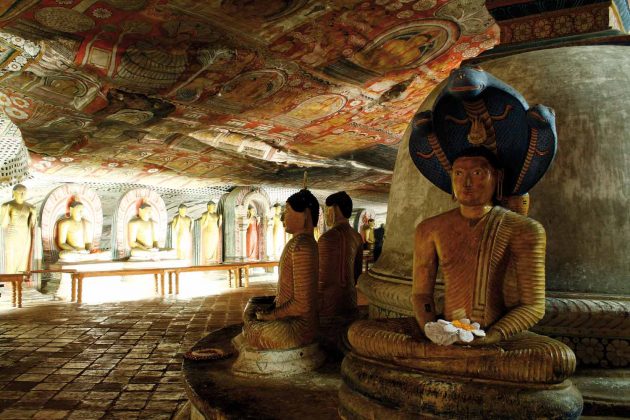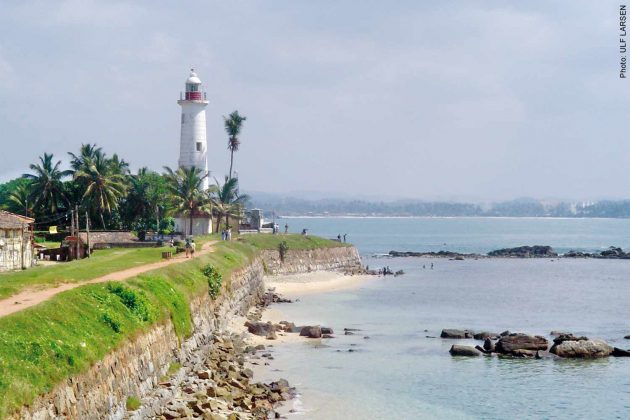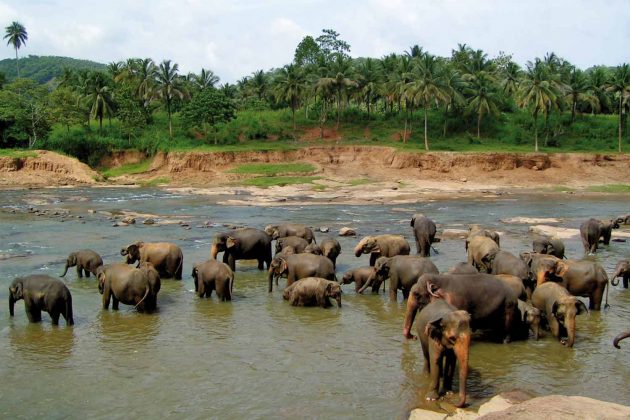Everything about Sri Lanka keeps you coming back for more—its accessibility, its breathtaking natural diversity, the warmth of Sinhalese hospitality and the vastness of the Indian Ocean. For a country so close to home, that seems so similar to India at face value, experiencing Sri Lanka is the only way to truly appreciate the uniqueness of the island that makes it so different from anywhere else. I wanted my time in Sri Lanka to be one of discovery, where I could get a sense of its history, its people and its culture. So I started where it all began—in the ancient cities.
Kandalama and the cultural triangle
Nestled practically at the centre of the island, Kandalama was an excellent start to my trip—so removed from modern civilisation, its lush green set my clock back to zero, making room to absorb all that I wanted to see and learn. It makes for a picturesque and tranquil base when visiting the popular cultural triangle, the seat of Sri Lankan culture—the ancient city of Anuradhapura, the rock temples of Dambulla and the Sigiriya rock fortress. I was pleasantly surprised at the extent to which heritage is valued and preserved. At Anuradhapura, I was transported in time with the ingenious architecture of centuries gone by, a fraction of which has stood the test of time and offers glimpses of a long forgotten past. Set in luscious green, it was the perfect place to rent a cycle, witness the fervent devotion of thousands thronging the Buddhist temples, and enjoy refreshing coconut water while hearing stories of the glory that the city once represented. Sri Lankans are warm people, always willing to strike up a friendly conversation and proud to be storytellers of their culture and tradition.
Seaside surrender
The train ride from Colombo to Galle is probably the most memorable train journey in anyone’s life time—the sound of crashing waves, the sun setting in the sea in a flurry of orange, yellow and purple, an unadulterated sea view from start to end as the tracks flirt with the coastline so close I could almost taste the salty water. After miles of sleepy villages, seaside resort getaways and countless coconut trees, I almost didn’t want to get off at the walled town of Galle. The Dutch influence in Galle is palpable. Its tiny, winding, paved streets are lined with colourful houses and small cafés. Galle is the perfect location to author a masterpiece, if you ever feel like it. It’s also a convenient tuk tuk ride away from Lanka’s most beautiful beaches. I spent a morning trekking through thick foliage and crossing small streams, pointed in the right direction by a kind stranger, to stumble upon Jungle Beach—a spot of sand tucked away in a small bay, where the waves don’t reach, and the water can lull you into a catatonic state. Next I made my way to Unawatuna, which means ‘just dropped’. Legend has it that Hanuman dropped a piece of the Himalayas here. Apparently the medicinal herbs that grow in Unawatuna are identical to those found in the Himalayas. The damage wreaked by the 2004 tsunami is evident in Unawatuna. While some beach businesses suffered considerable damage, tourism has definitely regained its momentum, with numerous beachside stays offering stunning views of the iridescent blue. My favourite beach, Mrissa, is located an hour away from here. One of the few relatively untouched beaches in Sri Lanka, I could see myself spending a lifetime on Mrissa’s white sands. I was blown away by the immense Indian Ocean, where I had to dive under the waves to make it past the shoreline, where no significant landmass separated the water I was floating on from Antarctica. After a week spent in quasi shipwrecked bliss, my batteries were charged to return to some amount of modernity.
Between colonial and cosmopolitan
There are few capital cities where the pace of life seems almost laidback, reminiscent of a seaside retreat. Sri Lanka’s capital Colombo presents a unique mix of old world colonial charm, history and cosmopolitanism. While the trendy, young activities on offer include shopping malls and night clubs, the real pulse of the city is to be found elsewhere—feeding an elephant at the Gangaramaya temple and being humbled at the sight of centuries of Buddhist learning that the temple houses. There’s a sense of serenity that keeps you rooted to your sport, perhaps it’s the almost uncountable statues of the Buddha. Colombo’s markets are teeming with edible sundries and bales of vibrant cotton. They’re pretty much deserted by 4pm when most of the city has wisely chosen to indulge in a siesta—with relatively noise free tree-lined streets it’s hard to resist. A walk down the sea face, when the sun is gentler, is one of the best ways to absorb Colombo’s heritage. The numerous Victorian facades, some dilapidated, some restored send you back to a time when high tea was the only late afternoon activity. Colombo’s relaxed pace makes it a necessary buffer between the tranquillity of the seaside and a return to city life.
This was first published in the September 2012 issue of Complete Wellbeing.






